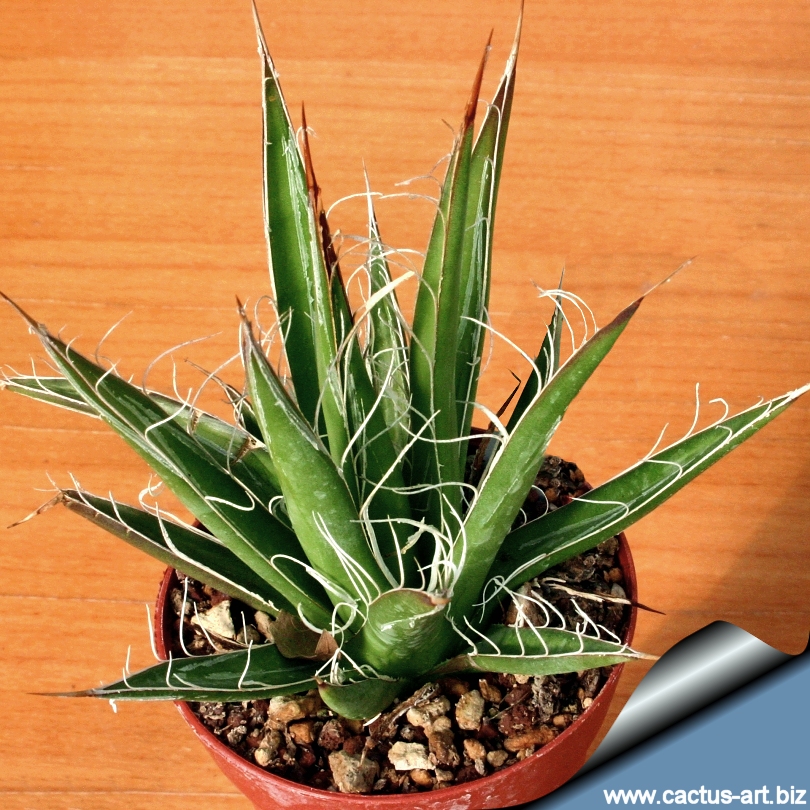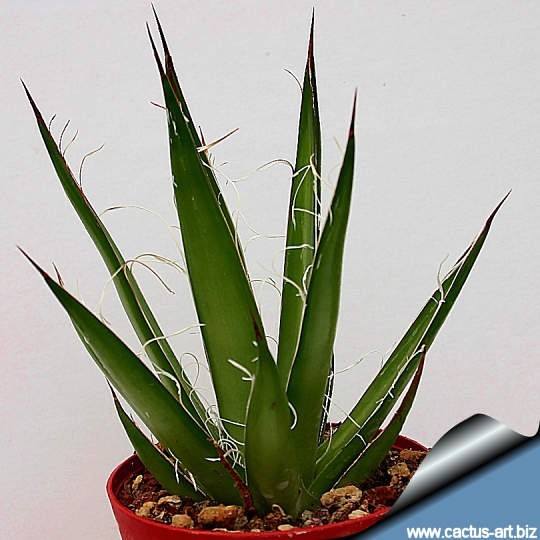|
|
|

Agave schidigera (La Congoja)
It is decorated with thin white curly marginal fibres spreading in all
directions which sometimes are very dense.
|
|
Description:
Agave schidigera is a small or medium sized plant that forms
stemless
rosette to 60 to 90 cm across and 60 cm tall. It is a very
symmetrical plant with straight leaves that looks a bit like Agave
filifera, perhaps having slightly wider leaves than A filifera,
but stay mostly solitary or suckers slowly but steadily. While the
A. filifera branches prolifically. Some populations of
Agave schidigera have slightly curved leaves that detract from
the symmetry.
Leaves: 30 to 45 cm long and 2,5 cm wide at their widest point.
They are decorated with thin white curly marginal
fibres spreading in all directions which sometimes are very dense.
There are no marginal teeth on the leaves; however, the tip is very
sharp and can inflict some damage. The leaves which vary in colour (on
the same plant) from dark green to a bronzish-green colour have very
ornamental white bud imprints. These imprints vary in tone and become
more noticeable with age.
Flower: The flower stalk is 3 to 3,5 m tall and is densely loaded
with yellowish-green to dark purple flowers up to 5 cm long. Some send
up a tall flower spike annually, while others bloom only every 30 to 40
years. Several types die after flowering, but new plants may develop
from suckers at their base.
Blooming Season: Late Spring through Early Summer.
|
|
Photo of conspecific taxa, varieties, forms and
cultivars of plants belonging to the
Agave filifera
complex
(
Traditional uses:
A. schidigera is one of the
species from which tequila is made. Rope, food, soap and other products
are also made from the fibers and pulp.
|
|


Advertising
|
|
|
|
Family: Agavaceae
|
|
Scientific name: Agave
schidigera Lemaire
(Often mispelled as "schindigera")
Origin: Mexico
(Chihuahua, Durango, Sinaloa, Sonora)
Habitat: Grows
on steep walled cliffs and open, exposed sites in oak woodlands from 900
to 2500 m elevation.
Common English Names include: Maguey
|
Synonyms:
- Agave filifera ssp.
schidigera (Lemaire) B.Ullrich
- Agave filifera var.
schidigera
- Agave discreptata
- Agave perplexans
- Agave vestita
- Littaea rezlii
- Agave taylorii
|
|
|
|

Because of its symmetrical form and relatively small size, this plant is
very attractive when grown in pots.
Cultivation: Good
in containers. Agave schidigera
is a relatively easy-to-grow species tolerant of most soils. The
only requirement is that it have good drainage and not be waterlogged.
Plants have a moderate growth rate,
responding to some supplemental water during the growing season (spring
through early fall). It is theoretically hardy to
-7° C , particularly when dry. It
is damaged from early morning overhead watering in the winter. The
water froze resulting in pockmarks on the leaves.
It grows fairly fast in summer if provided with copious water but
allows to dry thoroughly before watering again. During the winter
months, one should only water enough to keep the leaves from
shrivelling. They do well in full sun or a lightly shaded area. Plants
cultivated outdoors are drought tolerant and takes blasting heat and
full sun. Benefit from fertilization in the spring and summer.
It is quite versatile. Because of its symmetrical form and relatively
small size, this plant is very attractive when grown in pots. Plants can
be grouped together or planted among boulders in a rock or cactus
garden. They work well with perennials
Propagation: By
suckers which often are found growing around the base of the
plant, Remove the basal suckers (if available) in spring or summer
and let the cuttings dry for a few days before inserting in compost or
by seed.
|
|